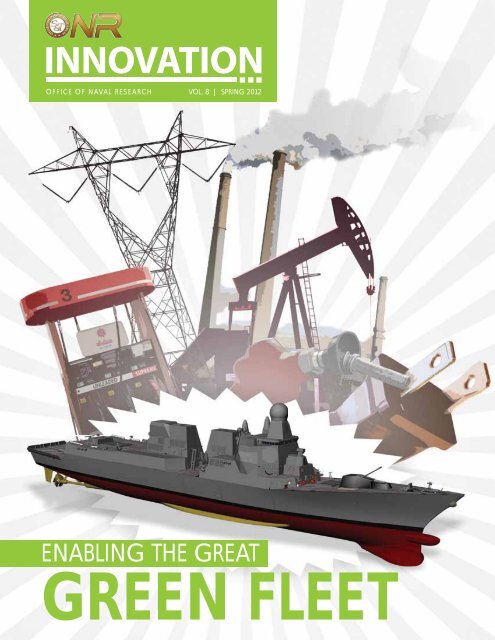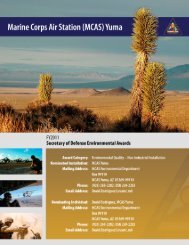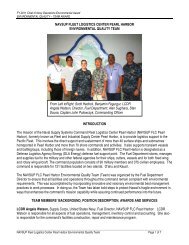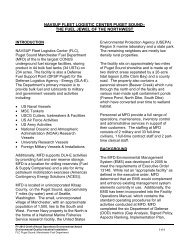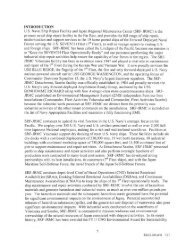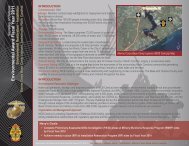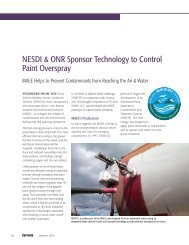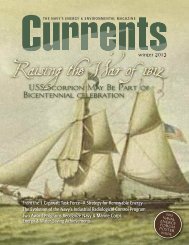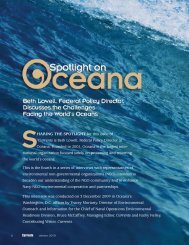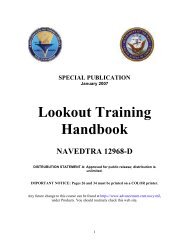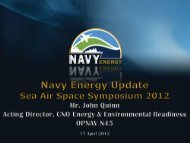Enabling the Great Green Fleet - Office of Naval Research (ONR ...
Enabling the Great Green Fleet - Office of Naval Research (ONR ...
Enabling the Great Green Fleet - Office of Naval Research (ONR ...
Create successful ePaper yourself
Turn your PDF publications into a flip-book with our unique Google optimized e-Paper software.
Vol. 8 | Spring 2012www.onr.navy.mil/innovateINNOVATIONOFFICE OF NAVAL RESEARC H VOL. 8 | SPRING 2012ENABLING THE GREATGREEN FLEET
www.onr.navy.mil/innovate w.o navy.milnnovateVol. 8 | Spring p 2012LETTER FROMTHE NEW CHIEF OF NAVAL RESEARCHChief <strong>of</strong> <strong>Naval</strong> <strong>Research</strong> Mahew Klunder kicks <strong>of</strong>f<strong>the</strong> aernoon round <strong>of</strong> Rebound Rumble during <strong>the</strong>FIRST (For Inspiraon and Recognion <strong>of</strong> Science andTechnology) Robocs Compeon being held at <strong>the</strong>Washington Convenon Center in Washington, D.C.FIRST combines <strong>the</strong> excitement <strong>of</strong> sports with <strong>the</strong> rigors<strong>of</strong> science and technology where teams <strong>of</strong> high schoolstudents design, build and program robots to performprescribed tasks against a field <strong>of</strong> competors. (U.S.Navy photo by John F. Williams/Released)IN THISISSUERADM Matt KlunderOur Navy connues to deploy new innovavevehicles, vessels, and aircra that make today’ssystems more effecve and affordable andtomorrow’s a leap ahead from our currentcapabilies. This diverse fleet <strong>of</strong> systems andplaorms requires efficient power sources tooperate opmally and affordably. Here at <strong>ONR</strong>,we are focused on three key characteriscs<strong>of</strong> energy systems to meet <strong>the</strong> needs <strong>of</strong> ourfuture <strong>Fleet</strong> and Force: Mobile, Marime,and Affordable.The Navy uses 75% <strong>of</strong> its energy afloat,creang a unique need for energy sourcesthat are both efficient AND portable. Thisdemand for mobility is oen not met bycurrent, commercially-viable energy soluons.Our challenge is to develop new methods forconversion, distribuon and control to meet <strong>the</strong><strong>Fleet</strong> and Force power demands for light-weightand low volume systems.Navy EnergyNumber and FactsFrom <strong>the</strong> Sea,Self Sufficient,CombatEffectiveMicrobe Power!Powering <strong>the</strong> LargeDisplacementUnmanned UnderseaVehicle for <strong>the</strong>Long Haul<strong>ONR</strong>’s TechSolutionsLights Up <strong>the</strong>Ship with <strong>Green</strong>Technology4 6 10 13 152
Vol. 8 | Spring 2012www.onr.navy.mil/innovateNot only are <strong>the</strong> Navy and Marine Corps mobile,but we operate in some <strong>of</strong> <strong>the</strong> harshest, mostcomplex environments. Boom line: futurepower systems must be able to operate reliablyand safely wherever our Sailors or Marines arefound. Whe<strong>the</strong>r at sea, in <strong>the</strong> air, on <strong>the</strong> groundor in space, we must be able to rely on <strong>the</strong>new energy sources to support and power usthrough any mission.Energy plays a large role in our operaonal andnaonal security vulnerabilies, so <strong>the</strong> <strong>Office</strong><strong>of</strong> <strong>Naval</strong> <strong>Research</strong> connues to invest in thisvital area even as budgets shrink across <strong>the</strong>Department <strong>of</strong> Defense. When we invest inour future energy systems, we must considertotal ownership costs when making investmentdecisions to ensure that inial costs areweighed against warfighng enhancements.We have a responsibility here at <strong>ONR</strong> and across<strong>the</strong> <strong>Naval</strong> <strong>Research</strong> Enterprise to ensure thatour Warfighters never face a day when <strong>the</strong>ycannot carry out <strong>the</strong>ir missions because <strong>the</strong>ydon’t have <strong>the</strong> energy resources <strong>the</strong>y need.Every Department at <strong>ONR</strong> is working on apiece <strong>of</strong> <strong>the</strong> energy challenge and our partnersthroughout <strong>the</strong> Navy are working too. Toge<strong>the</strong>rI am confident that we will make <strong>the</strong> type <strong>of</strong>progress we need, meeng <strong>the</strong> challenges <strong>of</strong>energy head on.I look forward to working with you toward thisimportant goal. •Power and EnergyFocusThe Business<strong>of</strong> EngineeringAlternative Fuels for<strong>Naval</strong> SystemsVariable CycleAdvancedTechnology: FutureEnergy Security for<strong>Naval</strong> AviationShipboard EnergyStorage ModuleenergyMMOWGLIThe U.S.–CzechInnovationConference:Exploring <strong>the</strong>InnovationOpportunity17 18 20 23 253
Vol. 8 | Spring 2012www.onr.navy.mil/innovate90 DAYSThe goal <strong>of</strong> <strong>the</strong> LargeDisplacement UnmannedUndersea Vehicle (LDUUV)Innovative <strong>Naval</strong> Prototype (INP)is to provide <strong>the</strong> Navy with <strong>the</strong>increased capability <strong>of</strong> poweringunmanned UUVs for a 60-90 dayperiod. The program is tryingto achieve <strong>the</strong> same enduranceas our buoyancy driven UUVs(i.e., gliders) with propellerdriven power. This would be ahuge breakthrough for propellerdriven UUVs as <strong>the</strong> current state<strong>of</strong> <strong>the</strong> art is just over one week.0The eventual goal <strong>of</strong> NavySEALs deploying this summeris net-zero energy and netzerowater. “They’re goingto use fl exible generatorsthat are many times moreeffi cient than <strong>the</strong> generatorswe’re using today. They’reusing portable solar batterychargers, portable solarrays, and highly portablewater purifi cation units,”according to SecretaryMabus at <strong>the</strong> Navy EnergyForum, October 2011.50-50Last September, <strong>the</strong> U.S. Navyfl ight demonstration team,<strong>the</strong> Blue Angels, conducteddemonstration fl ights witha 50-50 mix <strong>of</strong> bi<strong>of</strong>ueland JP-5 aviation fuel.NUMBERSAND FACTS5
www.onr.navy.mil/innovate r navy.mil/innovateVol. 8 | Spring 2012Solar power Ground RenewableExpedionary EnergySystem(GREENS) deployedin <strong>the</strong> field.FROM THE SEA,SELF SUFFICIENT,COMBAT EFFECTIVE6
Vol. 8 | Spring 2012www.onr.navy.mil/innovateHOW THE MARINES ARE INTEGRATING RENEWABLEENERGY TECHNOLOGY INTO THE FUTURE FORCEMs. Gayle Von Eckartsberg, Deputy Director, Expeditionary Energy <strong>Office</strong>, U.S. Marine Corps“To a Marine, <strong>the</strong> term ‘Expedionary’ is morethan a slogan; it is our state <strong>of</strong> mind. It drives<strong>the</strong> way we organize our forces, how we train,and what kind <strong>of</strong> equipment we buy.” In March2011, at <strong>the</strong> same me <strong>the</strong> Commandant <strong>of</strong><strong>the</strong> Marine Corps, General James Amos, madethis statement, <strong>the</strong> Marine Corps and <strong>the</strong><strong>Office</strong> <strong>of</strong> <strong>Naval</strong> <strong>Research</strong> (<strong>ONR</strong>) were movingout to deploy renewable energy capabiliesto Marines operang at <strong>the</strong> very edge <strong>of</strong> <strong>the</strong>balefield in Afghanistan. The objecve: equipa lighter, more energy efficient force, whichwould go far<strong>the</strong>r, stay longer, at less risk.Prototypes <strong>of</strong> <strong>the</strong> <strong>ONR</strong>-funded solar powerGround Renewable Expedionary EnergySystem (GREENS) deployed in early 2011,with India Company, 3 rd Baalion, 5 th Marineregiment. Operang under nearly constantcombat condions in <strong>the</strong> Sangin valley, <strong>the</strong>Marines put <strong>the</strong> equipment to work; <strong>the</strong>yreduced <strong>the</strong>ir risk pr<strong>of</strong>ile by powering twopatrol bases enrely on renewable energy,and reduced a Company’s COP fuel demand byover 80%. “With <strong>the</strong> right amount <strong>of</strong> panels,that [GREENS] system will power everythingwe need,” said India 3/5’s first LieutenantJosef Paerson. “I was a lile skepcal at first,that this is something new we have to tryout, but I’m completely sold on it. I think it’s agreat thing.”Power is an enduring requirement on <strong>the</strong>balefield, but since 2001, <strong>the</strong> demand forenergy has grown exponenally. Driving thiscurve are new capabilies Marines havebrought to bear on <strong>the</strong> enemy: a more than300% increase in <strong>the</strong> number <strong>of</strong> computers,a 250% increase in <strong>the</strong> number <strong>of</strong> radios, a200% increase in <strong>the</strong> number <strong>of</strong> vehicles, a 75%increase in vehicle weight due to greater armor,and a decrease <strong>of</strong> 30% in miles per gallon forvehicles across <strong>the</strong> fleet. As a result, <strong>the</strong> MarineCorps consumes upwards <strong>of</strong> 200,000 gallons<strong>of</strong> fuel daily in Afghanistan. The unintendedconsequences: increased reliance on fuelresupply, te<strong>the</strong>ring <strong>of</strong> Marine operaons, andincreased risk. According to a 2010 study, oneMarine is killed or wounded for every 50 fueland water convoys.GREENS deployed in early 2011, with India Company,3 rd Baalion, 5 th Marine regiment.7
www.onr.navy.mil/innovate Vol. 8 | Spring 2012The Marine Corps is about combat effecveness.For <strong>the</strong> Marines, <strong>the</strong> promise <strong>of</strong> renewableand hybrid energy is its value to expedionaryoperaons. Capabilies that reduce <strong>the</strong> logiscsrequirement, that allow forces to beer fit onships, that enable warfighters to operate longerand go fur<strong>the</strong>r when ashore, add up to a morecombat effecve force.GREENS HAD THE POTENTIALTO FIT THE BILLIn 2009, <strong>the</strong> Commandant <strong>of</strong> <strong>the</strong> MarineCorps jumpstarted <strong>the</strong> expedionary energyprogram, and created <strong>the</strong> Experimental ForwardOperang Base process, or ExFOB. By focusing<strong>the</strong> aenon <strong>of</strong> key players across <strong>the</strong> MarineCorps and <strong>Naval</strong> <strong>Research</strong> enterprise, ExFOBmoved <strong>the</strong> prototype system from test, throughend user evaluaon in CONUS and in <strong>the</strong>ater, torequirements development and into acquisionin less than two years. In Spring 2011, feedbackfrom India Company 3/5 influenced <strong>the</strong> MarineCorps to accelerate deployment <strong>of</strong> GREENS t<strong>of</strong>ive baalions in <strong>the</strong>ater. The first produconsystems were deployed in December 2011, withmore than 100 systems on track to deploy byMarch 2012.This rapid transion from prototype to program<strong>of</strong> record required intense collaboraon from<strong>ONR</strong>, <strong>Naval</strong> Surface Warfare Center Carderock,Marine Corps System Command, MarineCorps Warfighng Lab, Marine Corps CombatDevelopment Command, and <strong>the</strong> Marine CorpsExpedionary Energy <strong>Office</strong>.Developed and tested by <strong>Naval</strong> Surface WarfareCenter Carderock, GREENS harvests energythrough <strong>the</strong> sun using a man-portable array <strong>of</strong>solar panels and storage baeries to provide anaverage <strong>of</strong> connuous output <strong>of</strong> 300 Was—<strong>the</strong>power needed to support small Marine combatoutposts, arllery, and radio and surveillancesystems, or o<strong>the</strong>r demands at <strong>the</strong> forward edge.<strong>Naval</strong> Air Warfare Center Weapons Divisionat China Lake assessed <strong>the</strong> final prototype,subjecng it to connuous power tesng intemperatures exceeding 116 degrees Fahrenheit.Even under <strong>the</strong>se condions, GREENS worked at85 percent capacity.“Systems like this allow [Marines] to chargerechargeable baeries and wean awayMajor SeanSadliertrains usersonGREEEENsin <strong>the</strong> fiele d.8
Vol. 8 | Spring 2012www.onr.navy.mil/innovatefrom throw-away, one me use baeries,which greatly reduces weight and resupplyrequirements,” said Jusn Govar, <strong>the</strong> teamleader for Advanced Power with MarineCorps Systems Command in an interview with<strong>the</strong> Marine Corps Base Camp Lejeune PublicAffairs <strong>Office</strong>.“Infantry baalions that are far forwarddo not have immediate access to a widerange <strong>of</strong> logiscs and maintenanceequipment; <strong>the</strong>refore, any source <strong>of</strong> powerthat requires no [military-grade fuel],low maintenance and no special skillsto operate becomes an instant success.GREENS is modular, portable, rugged andintuive enough to deploy in a combatenvironment. Units trained on GREENSas part <strong>of</strong> pre-deployment training haveprovided posive feedback.”opmized personnel performance as well asenergy storage o<strong>the</strong>r than liquid, expedionarywater harvesng, and energy efficient, combateffecve mobility.For <strong>the</strong> Marine Corps, <strong>the</strong> focus remainsintensely on power and energy capabilies thatmake for a lighter, faster, and more austerefighng force—<strong>the</strong> keys to <strong>the</strong> expedionaryfuture force. •JP-5&F-76— Major Sean Sadlier, a logiscs analyst with<strong>the</strong> Marine Corps Expedionary Energy<strong>Office</strong>, who trained users on and testedGREENS in <strong>the</strong> field with India Company 3/5.WHAT’S NEXT?expedionary energy as one <strong>of</strong> <strong>the</strong> six “crical”pillars <strong>of</strong> modernizaon for <strong>the</strong> Marine Corps.The mission <strong>of</strong> <strong>the</strong> Marine Corps ExpedionaryEnergy Strategy provides a compelling targetfor future investment: “By 2025, we willdeploy Marine Expedionary Forces that canmaneuver from <strong>the</strong> sea and sustain C4I and lifesupport systems in place; <strong>the</strong> only liquid fuelneeded will be for mobility systems which willbe more efficient than systems are today.” Toachieve this will require investment not only inprocurement, but in science and technology.The Expedionary Energy Water and WasteInial Capabilies Document (ICD), approved inSeptember 2011, toge<strong>the</strong>r with Marine CorpsScience and Technology Objecves released inJanuary 2012 provides <strong>the</strong> roadmap. Prioriesinclude expedionary energy harvesng,temperature-independent electronics, andJP-5 and F-76 are Navy unique fuels thathave demonstrated durability in <strong>the</strong> maritimeenvironment. The maritime environment bringsunique challenges to fuel and to <strong>the</strong> development<strong>of</strong> bi<strong>of</strong>uels, with signifi cant testing and evaluationnecessary to ensure <strong>the</strong> fuel can withstand <strong>the</strong>Navy environment—specifi c challenges suchas saltwater, handling, and storage life.NUMBERS9
www.onr.navy.mil/innovate Vol. 8 | Spring 2012MICROBEPOWER!Linda A. Chrisey, Ph.D, <strong>ONR</strong> Program <strong>Office</strong>r,<strong>Naval</strong> Biosciences and Biocentric TechnologiesFor <strong>the</strong> past dozen years, <strong>the</strong> <strong>Office</strong> <strong>of</strong> <strong>Naval</strong> <strong>Research</strong> (<strong>ONR</strong>) hasbeen supporng basic and applied research to understand anddevelop microbial fuel cells for various underwater and terrestrialapplicaons. Although amongst <strong>the</strong> smallest organisms on <strong>the</strong>planet, <strong>the</strong> discovery that certain bacteria can sustainably generateelectricity is big news.WHAT IS A MICROBIAL FUEL CELL?A microbial fuel cell (MFC) is a novel, “green” approach forgenerang electricity that <strong>ONR</strong> is developing for <strong>the</strong> persistentpowering <strong>of</strong> undersea devices. Like convenonal fuel cells, MFCshave two electrodes (an anode and a cathode) which are wired toallow <strong>the</strong> flow <strong>of</strong> electrical current. However, MFCs are special inthat <strong>the</strong>y use microbes as catalysts for generang electricity instead<strong>of</strong> chemical reactants.WHAT ARE “ELECTRICIGENIC” MICROBES?Nature is oen a source <strong>of</strong> inspiraon for new science andtechnology (S&T). Over millions <strong>of</strong> years <strong>of</strong> evoluon, organismshave adapted to <strong>the</strong> many unique environments that exist onour planet. A special class <strong>of</strong> bacteria known as metal-reducers,actually respire on minerals that include metal oxides and sulfate.These microbes consume organic molecules for fuel and generateelectrons which are transferred to <strong>the</strong> mineral. In 1999, <strong>ONR</strong>-fundedsciensts discovered <strong>the</strong>se bacteria could transfer electrons to anelectrode. When wired in a circuit with a cathode, small amounts<strong>of</strong> electrical current were produced and could be used to powervarious devices.Geobacter and Shewenella are two key electricity-generangbacteria that <strong>ONR</strong> is studying. Elucidang <strong>the</strong> physiology andgenecs that allows <strong>the</strong>m to produce electricity may lead toopmized MFC’s for praccal powering <strong>of</strong> devices.WHAT DOES A MICROBIAL FUEL CELL LOOK LIKE?(top) False-color image <strong>of</strong> Geobacter showingpilin (nanowire) network. Credit: PI Lovley,UMASS-Amherst. (boom) Shewanellaoneidensis strain MR-1 growing on hemate.Credit: Pacific Northwest Naonal Laboratory.<strong>ONR</strong> is exploring two types <strong>of</strong> MFCs in its program: chamberedand sediment. Chambered MFCs resembles convenonal fuelcells in that <strong>the</strong>re are anode and cathode chambers filled withan electrolyte, with a proton-exchange membrane separang<strong>the</strong> two chambers. Chambered MFCs have been used to powersmall portable generators, desalinaon systems, and wastewatertreatment systems. The Department <strong>of</strong> Defense is exploring MFClikeapproaches for wastewater treatment to aain energy-neutral,or possibly energy-posive processes, in order to help minimizelogiscally costly diesel fuel use at Forward Operang Bases.10
Vol. 8 | Spring 2012www.onr.navy.mil/innovateThe sediment MFC (see schemac at right) has been<strong>the</strong> primary focus <strong>of</strong> <strong>the</strong> <strong>ONR</strong> program, as it presentsunique opportunies for powering devices underwater.The anode is typically buried in <strong>the</strong> seafloor sedimentto protect it from oxygen, whereas <strong>the</strong> cathode floatsin <strong>the</strong> water column. Sediment organic maer is <strong>the</strong>“fuel” used by <strong>the</strong> MFC to produce electricity as thisorganic maer is connuously renewed through naturalprocesses; thus, MFCs are sustainable energy harvesngsystems. Because <strong>the</strong> power density is low, powermanagement systems have been designed to store<strong>the</strong> electricity produced, to convert <strong>the</strong> MFC power tousable voltages, and to minimize <strong>the</strong> power needed tobootstrap and run devices.WHY USE MFCS AND NOTCONVENTIONAL BATTERIES?Microbial fuel cell technology <strong>of</strong>fers an alternave toseawater baeries which have a finite lifeme and caninvolve hazardous reactants or products (e.g., lithium,hydrogen). Because MFCs require only renewableorganic fuel and can generate electricity directly, <strong>the</strong>yprovide a route to safe and persistent power in <strong>the</strong>undersea environment. Seawater baeries provideapproximately 100 W·hours/L—a finite lifeme thatdepends on <strong>the</strong> power consumpon rate. MFCs providelower but persistent power (approximately 0.05 W/L).At this power level, <strong>the</strong> seawater baery would dieaer 12 weeks whereas <strong>the</strong> MFC would connue t<strong>of</strong>uncon. Studies have shown MFCs can connuouslyprovide power for over three years. MFC’s havesuccessfully powered acousc pingers, hydrophones,acousc vector sensors, underwater modems andenvironmental sensors (such as oxygen, temperature,and conducvity sensors).Teledyne Benthos developed a highly efficientMFC power management package to enablepowering <strong>of</strong> a compact acousc modem.Chambered MFC. Credit: www.kids.esdb.bg/images/Microbial_Fuel_Cell.gif.HOW WILL THE NAVY USE MFCS?Current field demonstraons <strong>of</strong> MFCs have focused onpraccal device powering. <strong>ONR</strong> has demonstrated thatMFCs can operate in environments that range from 10 to1000m in depth, and from <strong>the</strong> tropics to <strong>the</strong> temperatePacific Northwest coast.The Space and <strong>Naval</strong> Warfare Systems Center (SPAWAR)–Pacific may use MFCs to power hydrophones whichtrack movement <strong>of</strong> endangered green sea turtles in SanDiego Bay. SPAWAR-Pacific has also developed a diverlessdeployment system which enables self-burial <strong>of</strong> <strong>the</strong>MFC-anode.A schemac showing a possible concept <strong>of</strong>operaon.11
www.onr.navy.mil/innovate Vol. 8 | Spring 2012SerialPortFlashMemoryMooring EyeBoltTransducerReal TimeClockBattery(top) Receiver used to track signals sent fromtags mounted on sea turtles (boom), whichhas been adapted to use MFC power. Courtesy<strong>of</strong> Dr. Bart Chadwick, SPAWAR–Pacific.The <strong>Naval</strong> <strong>Research</strong> Laboratory and SPAWAR–Pacific havebeen developing an MFC to connuously power a staonaryacousc array used for surveillance. This applicaon requiresnumerous anodes (photo at le) to generate approximately 1W <strong>of</strong>power connuously.Oregon State University, Teledyne Benthos and Harvard Universityhave deployed an MFC system at 900m depth <strong>of</strong>f <strong>the</strong> Californiacoast at <strong>the</strong> Monterey Accelerated <strong>Research</strong> System (MARS)underwater observatory. This field study aims to determine ifMFCs can power underwater modems along with o<strong>the</strong>r sensors(e.g., oxygen or water temperature sensors). Currently a TeledyneBenthos SM-75 modem (powered by <strong>the</strong> MARS observatory),receives data transmied by compact, MFC-powered modemswhich are located several hundred meters away.This ongoing demo, has proven that an MFC can successfully poweran underwater acousc modem as well as various sensors atimpressive ocean depths (see hp://www.mbari.org/mars/science/bmfc.html).Anodes (black cylinders above) used togenerate power for a staonary acousc arrayused for surveillance.Teledyne power management package.MFC aer being pushed into sediment with Remotely Operated Vehiclemanipulator. Courtesy Oregon State University.WHAT’S NEXT FOR <strong>ONR</strong> MFCS?Teledyne Benthos SM-75 underwater modemused for <strong>the</strong> MFC MARS demo.To date <strong>ONR</strong>’s program has shown that MFCs are a viable oponfor powering many devices <strong>of</strong> interest to <strong>the</strong> Navy, such as acouscpingers, modems, hydrophones and analycal sensors. As <strong>the</strong>sepro<strong>of</strong>-<strong>of</strong>-concept studies have been accomplished, <strong>the</strong> programis now focused on two main objecves: increasing power andimproving reliability in diverse underwater environments. Within<strong>the</strong> next five to seven years we expect to deliver a safe, sustainableand reliable approach for meeng <strong>the</strong> Navy’s needs for poweringunderwater surveillance systems. •12
Vol. 8 | Spring p 2012www.onr.navy.mil/innovatew n .navy m innonovatPOWERINGTHE LARGE DISPLACEMENT UNMANNEDUNDERSEA VEHICLE FOR THE LONG HAULMr. Dan Deitz, <strong>ONR</strong> Program <strong>Office</strong>r, Ocean Sensing and Systems Applications DivisionMr. Eric Dow, <strong>ONR</strong> Program <strong>Office</strong>r, <strong>Naval</strong> Materials DivisionIn today’s world where most everyone is usingsmall computers in <strong>the</strong>ir watches or phones,and supercomputers are a staple <strong>of</strong> almost anylarge industry, where you can even purchase arobot to clean your floors, it doesn’t take mucheffort to look around and see that automaonhas removed <strong>the</strong> burden <strong>of</strong> some <strong>of</strong> our oldtasks. Like <strong>the</strong> automated products you find in<strong>the</strong> commercial sector, <strong>the</strong> Navy and MarineCorps are also looking into <strong>the</strong>se technologiesas a way to reduce <strong>the</strong> manpower necessaryto operate some <strong>of</strong> its most basic funcons. Insupport <strong>of</strong> <strong>the</strong> Navy’s mission to have worldwidepresence and project power where andwhen it is needed, <strong>the</strong> <strong>Office</strong> <strong>of</strong> <strong>Naval</strong> <strong>Research</strong>(<strong>ONR</strong>) is taking on <strong>the</strong> task to fulfill this missionautonomously with <strong>the</strong> development <strong>of</strong>Unmanned Undersea Vehicles (UUVs).In parcular, <strong>the</strong> Large Displacement UnmannedUndersea Vehicle (LDUUV) Innovave<strong>Naval</strong> Prototype (INP) will develop <strong>the</strong> newtechnologies necessary to provide <strong>the</strong> Navywith <strong>the</strong> capability <strong>of</strong> operang UUVs for 60-90 days. This is a breakthrough for poweringUUVs as <strong>the</strong> current state <strong>of</strong> <strong>the</strong> art is justover one week. The increased persistence <strong>of</strong>UUVs will allow for enhanced parcipaon andawareness in many <strong>of</strong> <strong>the</strong> Navy’s missions toinclude: ansubmarine warfare; intelligence,surveillance, and reconnaissance; and minewarfare. But <strong>the</strong> LDUUV INP can also havea large impact at home as well. The 90 dayendurance period can provide constant wea<strong>the</strong>rsensors that improve our ability to forecast<strong>the</strong> wea<strong>the</strong>r and climate more accurately, canconduct more surveys <strong>of</strong> <strong>the</strong> crical shippingroutes to ensure safe transit <strong>of</strong> commercialshipping, and can allow for more me at sea forscienfic research in oceanography.In a me <strong>of</strong> shrinking budgets, it is imperavethat <strong>the</strong> Navy look to soluons that maintainits capability in an affordable way. The LDUUV13
www.onr.navy.mil/innovate Vol. 8 | Spring 2012SupportStructureLOXVaporizerUUV Fuel Cell DiagramINP provides <strong>the</strong> needed range and missioncapability to complete core missions without<strong>the</strong> need for deployed Sailors or ships. Whennecessary, <strong>the</strong> LDUUV INP can go into <strong>the</strong>dangerous areas or sea condions while keepingour Sailors and Marines safe on <strong>the</strong> ship or at<strong>the</strong>ir operang bases.The LDUUV INP will push technologydevelopment in three major areas: <strong>the</strong>development <strong>of</strong> new high energy dense powersystems that are safe aboard navy plaorms;<strong>the</strong> ability to autonomously navigate in<strong>the</strong> liorals; and <strong>the</strong> creaon <strong>of</strong> endurancetechnologies that allow a vehicle to operatein <strong>the</strong> open ocean for up to 90 days. The firsttechnology development area is new UUVenergy systems. Unlike many ships that canbrea<strong>the</strong> air, <strong>the</strong> UUV must carry its own oxygensource. This means standard diesel engineswill not work and more exoc sources must beconsidered. The UUV is also small comparedto submarines with equivalent endurance. TheLDUUV INP is looking for a very energy densesystem <strong>of</strong> over 1000 Wh/kg. The scale <strong>of</strong> thisresearch goal is like packing <strong>the</strong> LDUUV INPfull <strong>of</strong> TNT and its energy output into youroven for 90 days, all while making it safe foruse on ships. The challenge is in controlling<strong>the</strong> energy and efficiently drawing a smallamount <strong>of</strong> it from a source as energy dense asTNT, while conducng operaons safely in anaval environment.The energy development is an enormousand somewhat daunng challenge when youconsider <strong>the</strong>se forward deployed and fullysubmerged UUVs need to operate connuously14LOX FillTubeLOX CryostatLOXPre-HeaterProduct WaterStorageLH 2VaporizerLH 2CryostatLH 2Pre-HeaterLH 2Fill TubeCoolingSystemFuel Cellfor greater than 60 days without re-charging.Just think about it, if UUVs were to rely solelyon today’s best baeries, <strong>the</strong>y would operatefor less than five days before needing to be recharged!In addion to <strong>the</strong> primary challenge<strong>of</strong> storing large amounts <strong>of</strong> energy in smallvolumes, <strong>the</strong> secondary challenge is to developpower conversion technologies which areupwards <strong>of</strong> three mes more efficient thantoday’s best automobile engines all <strong>the</strong> whilebeing much more reliable. Imagine being ableto run you car’s engine for over 1000 hours<strong>of</strong> connuous driving, or about 40,000 miles,without ever having an oil change or conducngroune maintenance! The technology soluonswhich are possible candidates to address <strong>the</strong>sechallenges are several, some <strong>of</strong> which couldinclude srling engines, solid oxide fuel cells,polymer electrolyte membrane fuel cells or<strong>the</strong>rmal combustors, to name a few. Several<strong>of</strong> <strong>the</strong>se technologies could be ‘hybridized’ orcombined with o<strong>the</strong>r energy storage devices,such as baeries or capacitors, in an aemptto make <strong>the</strong> overall system more efficientthroughout its operang regime as it goesfrom very low power (loitering, waing) to veryhigh power (accelerang, sprinng). Lastly,<strong>the</strong>se systems must include any necessaryenergy storage sub-systems for efficientpower conversion to <strong>the</strong> vehicles’ payloadsand propulsion system, all <strong>the</strong> while providingin excess <strong>of</strong> 600 Wh/l on a fully integratedsystems basis.<strong>ONR</strong> is on its way to solving <strong>the</strong>se energychallenges and delivering to <strong>the</strong> Navy andMarine Corps innovave and safe UUV energytechnology for <strong>the</strong> LDUUV INP. The LDUUVINP is ancipated to be tesng this technologyin 2018. These experiments will aim todemonstrate that UUVs can operate in <strong>the</strong> openocean providing mission capabilies to both<strong>the</strong> Navy and <strong>the</strong> Department <strong>of</strong> HomelandSecurity, without <strong>the</strong> need for support ships.The energy technology emerging from <strong>the</strong>LDUUV INP program will provide <strong>the</strong> capabiliesneeded to meet <strong>the</strong> Navy’s UUV near-termand far-term objecves in persistent, forwardpresence. Perhaps more importantly, it willenable manned plaorms to be kept hundreds<strong>of</strong> miles removed from areas <strong>of</strong> conflict,resulng in reduced risk to naval personneland plaorms. •
Vol. 8 | Spring 2012www.onr.navy.mil/innovatenavy.mil/innovat<strong>ONR</strong>’S TECHSOLUTIONSLIGHTS UP THE SHIPWITH GREEN TECHNOLOGYMs. Dylan Ottman, TechSolutions Program AnalystUnited States Navy Sailors andMarines aboard submarinesand surface ships know toowell <strong>the</strong> irritang buzzingsound <strong>of</strong> fluorescent lights.Tired <strong>of</strong> <strong>the</strong> distracng soundmade by fluorescents and<strong>the</strong> intensive maintenanceprocedures associated with<strong>the</strong> lighng fixtures, a Navysonar technician decided totake acon. Knowing <strong>the</strong>remust be a beer lighng oponavailable, he reached out to <strong>the</strong>Navy’s science and technologycommunity hoping <strong>the</strong>y could<strong>of</strong>fer a soluon. Luckily, he gotin touch with <strong>the</strong> right team for<strong>the</strong> job: TechSoluons at <strong>the</strong><strong>Office</strong> <strong>of</strong> <strong>Naval</strong> <strong>Research</strong> (<strong>ONR</strong>).TechSoluons’ projects areiniated in direct response torequests <strong>the</strong>y receive fromindividual Sailors and Marines.The request to replace anoisy fluorescent bunk lightwith a quieter light bulb wassubmied by a sonar technicianat Submarine Force Atlanc(SUBLANT), Norfolk, VA. Notonly are <strong>the</strong>se fluorescent lightfixtures noisy, but <strong>the</strong>y containhazardous materials, aremaintenance intensive, and areeasily damaged.Upon receiving <strong>the</strong> request,TechSoluons beganinvesgang g alternave lightfixtures. The three main lightsources are incandescent,fluorescents and Light EmingDiodes (LEDs). Incandescentlight bulbs are an even oldertechnology than fluorescentlight bulbs. Incandescent lightbulbs are highly wasteful andmost variees convert lessthan 10% <strong>of</strong> <strong>the</strong> energy <strong>the</strong>yuse into visible light, with<strong>the</strong> remaining energy usedbeing converted into heat.LEDs are a newer technologyand are gradually replacingincandescent and fluorescentfixtures. LED fixtures improve<strong>the</strong> rao <strong>of</strong> visible light to heatgeneraon and are consideredenergy-efficient lighng. Inaddion to <strong>the</strong> humming sound<strong>the</strong>y make, <strong>the</strong>re are o<strong>the</strong>rissues associated with <strong>the</strong>sefluorescent fixtures that render<strong>the</strong>m less than ideal for shipsand submarines. Fluorescentfixtures are unreliable andrequire a lot <strong>of</strong> maintenance,<strong>the</strong>y break easily, are noisyand expensive. LEDs alsoknown as solid state lighng,are an excellent alternave t<strong>of</strong>luorescents, thus improvingSailors quality <strong>of</strong> life andhelping to boost <strong>the</strong> Navy’senergy efficiency.Exisng fluorescent lighngsystems on board Navy vesselsare maintenance intensive. Theoperaonal bulb life <strong>of</strong> <strong>the</strong> LEDfixture is longer, lasng up to50,000 hours, compared with<strong>the</strong> fluorescents, which onlylast up to 7,500 hours. The LEDfixture’s significantly longerlife means it does not need tobe purchased and replacedas oen, thus minimizingmaintenance for <strong>the</strong> Sailorsand disposal costs for <strong>the</strong>Navy as well as reducing <strong>the</strong>number <strong>of</strong> spare bulbs needed.Unlike fluorescent bulbs, whichcontain mercury, LED bulbscontain no hazardous materials,thus fur<strong>the</strong>r lowering disposalcosts and eliminang specialdisposal procedures.Ano<strong>the</strong>r benefit <strong>of</strong> replacing<strong>the</strong> old fluorescent fixtureswith solid state lighng is <strong>the</strong>improved energy efficiencyacross <strong>the</strong> fleet. Solid statelighng consists <strong>of</strong> low-power,high-reliability, light-emingdiode (LED) fixtures. The LEDLED light designed by EnergyFocus Ltd. (U.S. Navy photo byJohn F. Williams/Released)15
www.onr.navy.mil/innovate Vol. 8 | Spring 2012fixtures match <strong>the</strong> form, fitand funcon <strong>of</strong> <strong>the</strong> old 8WT5fixtures and provide more lightoutput for <strong>the</strong> same powerinput. Over me, solid statelighng could also help <strong>the</strong>Navy save in fuel costs and lessfuel consumed could result in acost savings for <strong>the</strong> Navy.<strong>Naval</strong> leaders have issued a set<strong>of</strong> ambious new goals to boost<strong>the</strong> Navy and Marine Corps’energy efficiency and solidstate lighng supports <strong>the</strong>irplans to make <strong>the</strong> Navy moregreen. One <strong>of</strong> <strong>the</strong>se goals is tosignificantly reduce <strong>the</strong> Navy’sconsumpon <strong>of</strong> petroleum.One <strong>of</strong> <strong>the</strong> main petroleumproducts used by <strong>the</strong> Navy isdiesel fuel consumed by ships.Some <strong>of</strong> this diesel fuel isconsumed by <strong>the</strong> generaon<strong>of</strong> electricity used to power<strong>the</strong> lights on <strong>the</strong> ship. Becausesolid state lighng uses lesselectricity to generate <strong>the</strong>same light output, LEDs help tosave fuel.For this project, TechSoluonswent above and beyond <strong>the</strong>irtypical scope <strong>of</strong> work in orderto get <strong>the</strong> solid state lighngfixtures on board. While <strong>the</strong>LED fixtures matched <strong>the</strong> form,fit and funcon <strong>of</strong> <strong>the</strong> 8WT5fixtures, TechSoluons firsthad to update <strong>the</strong> militaryspecificaons (MILSPECs)to allow <strong>the</strong> use <strong>of</strong> solidstate lighng on board shipsand submarines. BeforeTechSoluons could install<strong>the</strong> prototype technologyon board any Navy vessel,<strong>the</strong>y had to pay to have <strong>the</strong>MILSPECs changed to permitsolid state lighng on boardships and submarines. Since<strong>the</strong> MILSPECs did not allow for<strong>the</strong> installaon <strong>of</strong> solid statelighng fixtures on ships andsubmarines, <strong>the</strong> team fundednot only <strong>the</strong> developmentand cerficaon <strong>of</strong> <strong>the</strong> LEDfixtures, but also had <strong>the</strong> NavyMILSPECs changed to allowsolid state lighng on Navyships and submarines.TechSoluons’ solid statelighng project improves<strong>the</strong> quality <strong>of</strong> life for Sailors.First, by replacing fluorescentbulbs with LED bulbs, Sailor’smaintenance and repairworkloads are significantlyreduced. The LED fixtures donot break as easily and lastlonger than fluorescents, thusallowing Sailors to focus onmore important challenges.Next, installing solid statelighng in place <strong>of</strong> fluorescentsfrees up storage space on<strong>the</strong> ship or submarine. Amajor issue for <strong>the</strong> Sailorson submarines is <strong>the</strong> lack <strong>of</strong>space for <strong>the</strong>mselves and <strong>the</strong>irequipment. Sailors currentlyhave to store hundreds <strong>of</strong>addional fluorescent bulbsto replace broken bulbs. Also,Sailors must store broken bulbson board, taking up even morevaluable space.“For over 22 years, I was anelectronics technician on boarda submarine where storagespace is at a premium. Helping<strong>the</strong> Sailors free up some <strong>of</strong><strong>the</strong> space used for storinglight bulbs was in <strong>the</strong>ir bestinterest and <strong>the</strong>refore mypriority,” said Command MasterChief Ziervogel, head <strong>of</strong> <strong>the</strong>TechSoluons program under<strong>ONR</strong>’s Director <strong>of</strong> Innovaon.TechSoluons solid statelighng could eventuallyreplace fluorescent fixtureson board surface shipsand submarines across <strong>the</strong>Navy. The Navy has alreadyordered more fixtures to beinstalled on board <strong>the</strong> USSNew Hampshire. The originaloperaonal alteraon to <strong>the</strong>USS New Hampshire has beenextended from 33 inial fixturesto include all 8WT5 fixtures in<strong>the</strong> forward secon <strong>of</strong> <strong>the</strong> ship.This includes 269 addionallight fixtures for a total <strong>of</strong> 302fixtures on board <strong>the</strong> USS NewHampshire. Solid state lighngis showing great promise onboard Navy vessels and solidstate lighng usage fleet-widecould add up to considerablesavings and improvedreadiness. Solid state lighngis just one <strong>of</strong> several rapidresponse technologies beingfunded by TechSoluons usingrecommendaons from Navyand Marine Corps personnel. •About TechSoluons16TechSoluons is a rapid-response science and technology (S&T) program focused on producing prototypetechnologies to meet requests submied by United States Sailors and Marines. Rapid responsetechnology reaches <strong>the</strong> fleet quickly and is significantly faster than <strong>the</strong> standard DoD technologyacquision cycle. TechSoluons is an innovave business process that works to bridge <strong>the</strong> gap between<strong>the</strong> warfighter and <strong>the</strong> scienst. Accepng requests directly from Sailors and Marines, TechSoluonsteams up with government researchers to develop a soluon. TechSoluons aims to put <strong>the</strong> prototypesoluon in <strong>the</strong> hands <strong>of</strong> <strong>the</strong> requesng warfighter within 12-18 months <strong>of</strong> <strong>the</strong>ir submission.
Vol. 8 | Spring 2012www.onr.navy.mil/innovateTHE BUSINESS OF ENGINEERINGALTERNATIVE FUELS FOR NAVAL SYSTEMSMs. Sharon Beermann-Curtin, <strong>ONR</strong> Program <strong>Office</strong>r, Power and Energy Technical LeadWhen President Obama addressed <strong>the</strong> Naon atthis year’s State <strong>of</strong> <strong>the</strong> Union, it was clear that hehas a strategy geared towards developing, “everyavailable source <strong>of</strong> American energy,” and tha<strong>the</strong> is looking to <strong>the</strong> Navy to play a major role inimplemenng his clean energy plans:“And I’m proud to announce that <strong>the</strong>Department <strong>of</strong> Defense, <strong>the</strong> world’s largestconsumer <strong>of</strong> energy, will make one <strong>of</strong> <strong>the</strong>largest commitments to clean energy inhistory – with <strong>the</strong> Navy purchasing enoughcapacity to power a quarter <strong>of</strong> a millionhomes a year.”From <strong>the</strong> statement made above, to <strong>the</strong> increasedinvestment in energy programs, it is clear that<strong>the</strong> Navy is seen as a driving force in moving <strong>the</strong>naon towards <strong>the</strong> ability to use alternave fuels.In fact, Secretary <strong>of</strong> <strong>the</strong> Navy Ray Mabus has setambious alternave fuel goals for <strong>the</strong> Navy thatare driving commercial research as well as marketstrategy. In parcular, one <strong>of</strong> Secretary Mabus’goals is to sail <strong>the</strong> <strong>Great</strong> <strong>Green</strong> <strong>Fleet</strong> in 2016. The<strong>Great</strong> <strong>Green</strong> <strong>Fleet</strong> will likely include all <strong>of</strong> <strong>the</strong>plaorms found in an Aircra Carrier Strike Groupand will demonstrate <strong>the</strong> ability to use alternavefuel sources in our current naval systems with nodetrimental effects to <strong>the</strong> marime or aviaonsystems. In <strong>the</strong> long run, <strong>the</strong> Navy is confidentthat our ability to use alternave fuels will ensureresiliency in <strong>the</strong> event <strong>of</strong> a global oil crisis.To achieve <strong>the</strong> <strong>Great</strong> <strong>Green</strong> <strong>Fleet</strong> goals <strong>the</strong> Navyneeds to overcome a significant number <strong>of</strong>challenges. The Navy operates in harsh marimeenvironments and pracces which introducetaxing parameters. The saltwater environmentand our logiscs for underway replenishment, aswell as storage and handling, make it impossibleto eliminate seawater from entering <strong>the</strong> fuel.The pracce <strong>of</strong> seawater ballasng in fuel tanksis unique, adding addional opportunies formicrobiologic induced corrosion as well asdegradaon <strong>of</strong> <strong>the</strong> fuel. In conjuncon with <strong>the</strong>marime environment challenge, <strong>the</strong> Navy alsohas to qualify a variety <strong>of</strong> fuels meant for differentplaorms (aviaon fuels, e.g., JP-5, and marimedisllate fuels, e.g., F-76). The Navy has longlife stability requirements as well as extensivehandling from ship to ship as well as from shoreto ship and from ship to aircra. Lastly, <strong>the</strong>re is arequirement for ‘drop-in’ fuels; all fuels qualifiedmust work on exisng systems.The <strong>Office</strong> <strong>of</strong> <strong>Naval</strong> <strong>Research</strong> Alternave FuelsProgram is invesng in a variety <strong>of</strong> programsmeant to enable <strong>the</strong> Navy and <strong>the</strong> <strong>Great</strong> <strong>Green</strong><strong>Fleet</strong> in meeng <strong>the</strong>ir goals. Of note, <strong>ONR</strong> iscurrently producing predicve modeling tools thatwill allow faster and less expensive qualificaons<strong>of</strong> new alternave fuels as <strong>the</strong>y come into <strong>the</strong>market place. Convenonal fossil fuels all mustfall within a certain specificaon and fit forpurpose properes. The Navy has experse inworking with fossil fuels; however, we need tobring in new techniques to establish <strong>the</strong> use <strong>of</strong>alternave fuels. Each alternave fuel that is beingdeveloped incorporates different conversionprocesses leading to a unique molecular makeup. These chemical composions determine afuel’s combuson characteriscs. To qualify afuel for each use on individual engines becomescost prohibive. Full engine tesng requires100,000 gallons <strong>of</strong> fuel to fully cerfy a new fuel.In addion, it takes me and experse to runa full-scale test, all <strong>the</strong> while tying up valuableassets. The ability to predict <strong>the</strong> combusonperformance given a molecular composion andintegrang it with gas turbine and diesel engine17
www.onr.navy.mil/innovate Vol. 8 | Spring 2012models, will allow <strong>the</strong> Navy to determine <strong>the</strong>ability <strong>of</strong> a fuel to perform on our systems beforewe invest in costly qualificaon tesng. To-date,we have already witnessed <strong>the</strong> use <strong>of</strong> alternavefuels both commercially and in our naval systems;from <strong>the</strong> use <strong>of</strong> ethanol in our cars to <strong>the</strong> alreadydemonstrated ability for aircra to fly and ships tosail using alternave hydrocarbon fuels. However,<strong>the</strong> ability to bring a new technology to marketgoes beyond <strong>the</strong> technology itself.The real driving force is <strong>the</strong> ability to bring<strong>the</strong> complete alternave fuels process intocompeon with fossil fuel costs. When looking at<strong>the</strong> challenge from this standpoint, it is necessaryto point out that conversion technologies are10-20% <strong>of</strong> <strong>the</strong> cost per gallon <strong>of</strong> bi<strong>of</strong>uel. Thebulk <strong>of</strong> <strong>the</strong> cost is in <strong>the</strong> feedstock producon.One <strong>of</strong> <strong>the</strong> challenges is ensuring <strong>the</strong> amount <strong>of</strong>biomass as well as <strong>the</strong> reducon <strong>of</strong> feedstock cost,along with <strong>the</strong> ability to transport <strong>the</strong> feedstockto <strong>the</strong> refinery. The ability to persuade farmersto produce non-edible crops, effecvely usefallow land, maximize growth management <strong>of</strong>feedstock and crop rotaon, efficiently transport<strong>the</strong> feedstock to biorefineries through co-locangcrops with relevant refineries, is no small featand is a significant part <strong>of</strong> <strong>the</strong> process. The <strong>ONR</strong>Alternave Fuels Program is currently workingwith <strong>the</strong> USDA and <strong>the</strong> Department <strong>of</strong> Energyon <strong>the</strong>se crical issues to ensure that when weneed alternave fuels we will be in a posion tonot only use <strong>the</strong>m but have a supply chain that iscapable <strong>of</strong> providing sustainability. In <strong>the</strong> future<strong>the</strong> success <strong>of</strong> alternave fuels for <strong>the</strong> Navysystems and plaorms will be determined bymarketplace, infrastructure, and economics. •Bi<strong>of</strong>uels Supply ChainFeedstockProductionFeedstockLogisticsBi<strong>of</strong>uelsConversionFuel Testing& ApprovalLarge ScaleDeployment• United StatesDepartment <strong>of</strong>Agriculture• United StatesDepartment <strong>of</strong>Agriculture / Department<strong>of</strong> Energy• Department <strong>of</strong> Energy• Defense Advanced<strong>Research</strong> ProjectsAgency• Advanced <strong>Research</strong>Projects Agency–Energy• Department <strong>of</strong> Defense• Federal AviationAdministration• Commercial AviationAlternative Fuels Initiative• Defense Logistics Agency• U.S. Marine Corps• U.S. Navy• U.S. Air ForceVARIABLE CYCLE ADVANCED TECHNOLOGYFUTURE ENERGY SECURITY FOR NAVAL AVIATIONDr. Joseph Doychak, <strong>ONR</strong> Program <strong>Office</strong>r, Division 351 Aerospace Science <strong>Research</strong>The <strong>Office</strong> <strong>of</strong> <strong>Naval</strong> <strong>Research</strong> (<strong>ONR</strong>) is alwaysthinking ahead and looking at what’s around<strong>the</strong> corner. Rapidly rising energy costs and<strong>the</strong> volality <strong>of</strong> energy supplies are twomajor challenges facing <strong>the</strong> Department <strong>of</strong>Defense (DoD) in <strong>the</strong> coming decades, and <strong>the</strong>Department <strong>of</strong> Navy (DoN) in parcular. <strong>Naval</strong>aviaon is desned to play a crical role inaddressing <strong>the</strong>se challenges. Recognizing thatpropulsion is a key technology enabling navalaviaon’s future capabilies to address <strong>the</strong>sechallenges, <strong>ONR</strong> is taking acon by developingnew engine technologies and making <strong>the</strong>mavailable for future naval aviaon missions.Fuel costs and supplies remain volale. DoD is <strong>the</strong>largest consumer <strong>of</strong> fuel amongst Governmentagencies. Aviaon is <strong>the</strong> primary consumer withinDoD. For <strong>the</strong> DoN, aviaon ranks right up <strong>the</strong>rewith ships in terms <strong>of</strong> fuel usage. More efficientengines would enhance aircra range andcapability, and go a long way towards reducing<strong>the</strong> impacts <strong>of</strong> high fuel cost and supply volality.18
Vol. 8 | Spring 2012www.onr.navy.mil/innovateVCATms.VCATis <strong>the</strong> powewer syststem thahat will be usedon fututureTACAIRandISR plalaorormsThe most recent DoD strategic guidance tled“Sustaining U.S. Global Leadership: Prioriesfor 21st Century Defense,” specifically calls out<strong>the</strong> need “to make <strong>the</strong> necessary investmentsto ensure that we maintain regional access and<strong>the</strong> ability to operate freely.” More efficientpropulsion systems will be required to extend <strong>the</strong>range and endurance <strong>of</strong> future Taccal Aircra(TACAIR) and Intelligence, Surveillance andReconnaissance (ISR) plaorms.Both <strong>the</strong> Air Force and Navy have beenlooking at variable/adapve cycle turbineengine technologies. Variable/adapve enginetechnology is any variable geometry enginecomponent or feature that can be changedto opmize engine performance and adapt tomulple operang points within <strong>the</strong> aircra’sflight envelope. Similar to changing gears in acar, changing an aircra engine’s bypass raoallows <strong>the</strong> engine to be opmized for high thrustwhen needed for take<strong>of</strong>f, while maintaining<strong>the</strong> efficiency <strong>of</strong> a high bypass engine in cruisecondions. The ability to change <strong>the</strong>se engineparameters inflight provides beer performanceand fuel efficiency across a range <strong>of</strong> flightcondions for naval aviaon, yielding an increasein combat mission capability and reduced fuelneeded to complete a given mission.The VCAT program is a partnership effortbetween <strong>ONR</strong> and DoN’s Task Force Energy (TFE)iniave. In close coordinaon with NAVAIR and<strong>the</strong> overall <strong>Naval</strong> Aviaon Enterprise, <strong>the</strong> VCATprogram’s objecve is to idenfy and maturecrical variable/adapve cycle turbine enginetechnologies for future carrier-based TACAIR/ISRnaval aviaon systems.Details <strong>of</strong> technologies associated with thosemarinizaon and carrier suitability aributeswere defined in a systems analysis effort iniallyfunded by TFE at <strong>the</strong> beginning <strong>of</strong> fiscal year2011. That study showed dramac improvementsin range and loiter capabilies for conceptualplaorms and missions. The benefits were dueto a combinaon <strong>of</strong> improved <strong>the</strong>rmal andpropulsive efficiencies from advanced materialtechnologies and <strong>the</strong> variable/adapve enginefeatures. Aligned with TFE goals, <strong>the</strong> studiesalso showed that <strong>the</strong>se technologies would<strong>of</strong>fer <strong>the</strong> potenal for significant reducons infuel consumpon—that means less demand fordeployed fuel and tanker aircra support.Once specific requirements are established for<strong>the</strong> next naval TACAIR/ISR system, performancethresholds and objecves will be determined for<strong>the</strong> engine. Unl that me, TFE goals associatedwith turbine engine efficiency and fuel burnreducon will be a primary driver for research onvariable cycle technology. Enhanced capability forfuture naval aviaon systems will connue to bean important part <strong>of</strong> <strong>the</strong> VCAT program’s visionfor <strong>the</strong> future. •19
www.onr.navy.mil/innovate w.onnavy.mil/ nnovateVol. l 8 | Spring spring 20121SHIPBOARDENERGY STORAGE MODULEMr. Donald H<strong>of</strong>fman, Program <strong>Office</strong>r,<strong>ONR</strong> Ship Systems and Engineering <strong>Research</strong> Division 331Presently, DDG-51 class ships account for asignificant poron <strong>of</strong> <strong>the</strong> total surface ship fuelconsumpon. To reduce <strong>the</strong> fuel consumponlevels in <strong>the</strong>se ships, various methods are beingused, including trail sha operaon as a commonmode <strong>of</strong> operang <strong>the</strong> ship, and pitch scheduling.However, fur<strong>the</strong>r fuel savings can be achievedthrough <strong>the</strong> incorporaon <strong>of</strong> Single GeneratorOperaons (SGO). SGO is an operang modewhere only a single electrical generator is ulizedto power an enre ship. This increases shipboardfuel efficiency through <strong>the</strong> reducon <strong>of</strong> <strong>the</strong> totalnumber <strong>of</strong> Gas Turbine Generators (GTG) kept online. Under <strong>the</strong> <strong>ONR</strong> SwampWorks, “Fuel Efficientand Power Dense Demonstrator” program,an advanced capability for SGO was examinedand demonstrated.The DDG-51 class engineering plant line-upincludes four propulsion turbines (GE LM-2500) and three Gas Turbine Generators (RollsRoyce AG9140 GTGs). Standard electrical plantalignment has been to always operate a minimum<strong>of</strong> two GTGs. This significantly reduces <strong>the</strong> risk <strong>of</strong>losing all ship service power due to <strong>the</strong> failure <strong>of</strong>one GTG. While this pracce maintains electricalplant integrity, <strong>the</strong> GTGs are operated rounelyat low, specific fuel consumpon design pointswhich sacrifices efficiency and increasing me perengine. The specific fuel consumpon for simplecycle gas turbines increases sharply, below 50%<strong>of</strong> load.In order to keep electrical plant integrity duringSGO plant alignment, a ride-through capabilityfor essenal services is necessary in case <strong>the</strong>GTG shuts down. This requires an instantaneouschangeover <strong>of</strong> supply in power to ride throughunl standby GTGs can be brought back on lineto assume ships load. Each GTG, by design, canbe started and assume full load in 60 secondsaer loss <strong>of</strong> shipboard electric power occurs. Thisrequires an Energy Storage Module (ESM) whichincorporates <strong>the</strong> energy storage device, such asbaeries, and high density power electronicsinterface. The ESM needs to be <strong>of</strong> size to maintaincrical ship’s load at a minimum or transparentplant operaons at maximum while allowing formulple GTG start aempts. In addion, <strong>the</strong> ESMneeds to be modular in design with high powerdensity to allow for flexible backfit installaons orfuture plant configuraon.20
Vol. 8 | Spring 2012www.onr.navy.mil/innovateHistorically, convenonal ESM designs have beenextremely large and <strong>the</strong>refore not suitable foruse in a shipboard applicaon. Recent effortsundertaken by <strong>the</strong> <strong>ONR</strong> SwampWorks Program,have resulted in an increase <strong>of</strong> <strong>the</strong> power densityand versality <strong>of</strong> <strong>the</strong> ESM’s power electronics.The overall ESM system design now allows moreroom for convenonal baery storage, provides<strong>the</strong> generic capability to interface with mulpletypes <strong>of</strong> energy storage, and allows <strong>the</strong> ESM to beupgraded as new energy storage devices becomeavailable and proven for shipboard installaon.What this really means is that inseron <strong>of</strong> <strong>the</strong>seadvanced energy storage technologies willprovide longer operaonal duraon and lighterweight with increased lifeme as compared toNavy state-<strong>of</strong>-<strong>the</strong>-art Valve Regulated Lead Acid(VRLA) baeries. VRLAs have typical lifemes <strong>of</strong>five to seven years depending upon how <strong>the</strong>y arecycled. Future inseron may include advancedlarge format lithium-ion baeries, once propershipboard safety protocols have been addressed.Lithium-ion baeries are capable <strong>of</strong> far greaternumber <strong>of</strong> cycles with sustained performance andmay <strong>of</strong>fer lifemes <strong>of</strong> double to three-mes <strong>the</strong>life <strong>of</strong> a typical VRLA.The ESM consists <strong>of</strong> a modular bi-direconal AC/DC power conversion system, controls, <strong>the</strong>rmalmanagement system, and standardized systeminterface devices, to work with any type <strong>of</strong> energystorage device such as advanced lithium-ionbaery system or convenonal VRLA. Overall, <strong>the</strong>ESM interfaces with <strong>the</strong> ships 450VAC distribuonand includes a high voltage DC-link for conneconwith <strong>the</strong> baery or o<strong>the</strong>r storage device. Thedevelopment <strong>of</strong> mulple line replaceable units(LRUs) for <strong>the</strong> bi-direconal AC/DC powerconversion led to a 66% improvement in powerdensity and 122% improvement in power capacityin comparison to a baseline LRU planned to beused in <strong>the</strong> DDG1000 Integrated Fight ThroughPower (IFTP) system. While <strong>the</strong> module size isnoonally 600 kW (5 would support a 3 MWload), <strong>the</strong> system can be scaled to meet shipboardpower and space needs. This modular concept isdesigned to be broken down into sub componentsto allow for shipment through exisng shiphatches and passageways. The unit can <strong>the</strong>n bereassembled in <strong>the</strong> required area for installaonthus allowing for easy backfit on exisng ships.Overall, <strong>the</strong> expected benefits <strong>of</strong> ulizing <strong>the</strong>developed system include but are not limited to<strong>the</strong> following:• Applicable to any shipboard class thatuses gas turbine and diesel electricalpower generaon.• Potenal fuel savings: > 8000 bbl/ship/yraboard DDG-51 Class ships.• Potenal to assist Hybrid Electric Drive– Propulsion Derived Ship Serviceoperaons for addional fuel savings.• Reducon in potenal for a “dark ship”condion.• Flexibility for backfit installaonulizing exisng shipboard hatch andpassageways.Systems in December 2010. This technologyhas been transioned to NAVSEA for fur<strong>the</strong>rdevelopment. This development will includeevaluaon <strong>of</strong> operaonal aspects and support <strong>of</strong>GTG and shipboard systems integraon.For <strong>the</strong> next generaon <strong>of</strong> mulfunconcapability, <strong>ONR</strong> is presently examining HybridEnergy Storage Module(s). Hybrid Energy StorageModule(s) with high power and energy densies,and high rate capability while achieving scalabilityat all power levels, will maximize performance,enhance fuel efficiency, and enable future highpower weapons and sensor systems on legacyand next generaon vehicles and plaorms. Thiscapability to store power dense electrical energyhaving variable charge and discharge rates inmodular-reconfigurable packages is projectedto extend fuel efficiency up to 40% in forwardoperang bases and military plaorms, whileproviding robustness and easy maintenance.The development <strong>of</strong> hybrid systems with <strong>the</strong>seenergy and power capabilies poses a uniqueset <strong>of</strong> technical challenges. To surmount <strong>the</strong>seshared and parallel challenges, a joint Advanced<strong>Research</strong> Projects Agency-Energy (ARPA-E) andAssistant Secretary <strong>of</strong> Defense for <strong>Research</strong> andEngineering (ASD(R&E)) program was announcedby Secretary <strong>of</strong> <strong>the</strong> Navy Ray Mabus at <strong>the</strong> ARPA-EEnergy Innovaon Summit on 2 March 2011.<strong>ONR</strong> is leading <strong>the</strong> effort on <strong>the</strong> ASD(R&E) side21
www.onr.navy.mil/innovate Vol. 8 | Spring 2012with an equal partner from ARPA-E. To date, thisprogram has iniated efforts impacng taccal toimprove fuel efficiency in <strong>the</strong> balefield; aircrato improve generator reliability; and large powerfor connuous pulse and fuel efficient operaon.In collaboraon, <strong>the</strong> ARPA-E’s AdvancedManagement and Protecon <strong>of</strong> Energy-storageDevices (AMPED) technology can <strong>the</strong>n potenallyextend <strong>the</strong> operaonal performance benefits andsafety for <strong>the</strong>se applicaons beyond <strong>the</strong> hybridstorage module baseline design configuraons.Overall, shipboard energy storage modulesprovide <strong>the</strong> potenal to enhance operaonsand provide fuel savings aboard both legacyand future plaorms. As ESM’s componenttechnologies improve in <strong>the</strong> future, <strong>the</strong>ir abilityto be fur<strong>the</strong>r integrated into shipboard electricalarchitectures and assist in maintaining overallsystem power quality will increase as well. •ESM cabinet dimensionsESMEnergy StoragePower Electronics(4x ~150kW LRUs,ThermMgmt)Balance <strong>of</strong> Plant(MstrCntrl, HMI,Cntrl PS)22
Vol. 8 | Spring 2012www.onr.navy.mil/innovateQ&AWITH THE energymmowgli TEAMCDR Jim Goudreau, OPNAV N45,Task Force EnergyDr. Larry Schuette,<strong>ONR</strong> Director <strong>of</strong> Innovation1) In just a few sentences, please give <strong>the</strong>audience an explanaon <strong>of</strong> what exactlyMassively Mulplayer Online WargameLeveraging <strong>the</strong> Internet (MMOWGLI) is:(Dr. Schuee) MMOWGLI is a new crowdsourcingtool that has been developed by <strong>the</strong> <strong>Office</strong> <strong>of</strong><strong>Naval</strong> <strong>Research</strong> and its partners, Instute for<strong>the</strong> Future and <strong>Naval</strong> Postgraduate School,to solve tough problems facing <strong>the</strong> Navy andMarine Corps. MMOWGLI is an online gameplaorm designed to elicit collecve intelligencefrom an engaged pool <strong>of</strong> world-wide playersto solve real problems. Mulmedia techniquesimmerse players into <strong>the</strong> game, where compellingcondions engage <strong>the</strong>ir aenon. Piracy <strong>of</strong>f <strong>the</strong>coast <strong>of</strong> Africa was <strong>the</strong> successful debut scenario.This reconfigurable plaorm can be adapted toany scenario, and <strong>ONR</strong> will next use MMOWGLIto find creave soluons to power and energyproblems. But it is a general-purpose tool suitablefor many uses.2) What do you hope to achieve wi<strong>the</strong>nergyMMOWGLI?(CDR Goudreau) We hope to increase <strong>the</strong>awareness <strong>of</strong> energy security as a naonalsecurity issue as well as smulang discussionthat will allow <strong>the</strong> Navy to achieve greater energyresiliency and combat capability.(Dr. Schuee) <strong>ONR</strong> is always looking for ways tobring new ideas into <strong>the</strong> building, to help buildnew concept <strong>of</strong> operaons (CONOPs), and to beintroduced to new principal invesgators whocan help us in our mission to develop futuretechnologies for our Sailors and Marines.3) What made you decide energy for <strong>the</strong>game’s scenario?(Dr. Schuee) With so many future outcomes in<strong>the</strong> energy arena and an expansive stakeholdercommunity, we chose a topic that we thoughtwould help unite such a ubiquitous field.Addionally, we wanted to find a customeroutside <strong>of</strong> <strong>ONR</strong> to use <strong>the</strong> MMOWGLI plaormand to benefit from <strong>the</strong> ideas played in <strong>the</strong> game.The Navy’s Task Force Energy was a naturalpartner and <strong>the</strong>y were interested in teaming up.The MMOWGLI plaorm is suitable for tacklinga broad range <strong>of</strong> challenges from macro-levelissues that impact naonal security and mulplestakeholders to micro-level, programmacchallenges that impact a smaller community.Aer <strong>the</strong> pilot on Somalia Piracy, <strong>the</strong> MMOWGLIcore team wanted to run a second scenariothat would bring to <strong>the</strong> game a broad range <strong>of</strong>players from different organizaons. Over <strong>the</strong>past decade, we have seen an increase in powerand energy research and investment across DoD,government, academia and industry.4) Could you give us an example <strong>of</strong> what <strong>the</strong> firstround <strong>of</strong> energyMMOWGLI would entail?(CDR Goudreau) The first round could be anexaminaon <strong>of</strong> what our energy future looks likeif we fail to act now. Every day that petroleumprices increase, it erodes our ability to train for23
www.onr.navy.mil/innovate Vol. 8 | Spring 2012and execute operaons that our naon demands<strong>of</strong> us. Lile by lile, that results in decreasedcombat capability, and that is something that wesimply cannot accept.5) Do you ancipate more or less parcipaoncompared to <strong>the</strong> first MMOWGLI round?(Dr. Schuee) I think <strong>the</strong> first round <strong>of</strong> MMOWGLIgameplay benefied from having <strong>the</strong> newnessfactor. However, I think this scenario is one thatmore people have a direct interest in. I think <strong>the</strong>Navy is going to get a lot <strong>of</strong> parcipaon from <strong>the</strong>public and I look forward to reading some <strong>of</strong> <strong>the</strong>novel ideas that are exchanged in game.6) What types <strong>of</strong> players do you ancipate forthis round <strong>of</strong> gameplay?(CDR Goudreau) We’re hoping for an extremelydiverse group <strong>of</strong> players including talented,thoughul players from academia, industry,military, government, NGOs and global cizens.7) O<strong>the</strong>r than <strong>the</strong> scenario, have <strong>the</strong>re been anymajor alteraons to <strong>the</strong> game?(Dr. Schuee) Since <strong>the</strong> pilot launched last year,we’ve made upgrades to <strong>the</strong> funcons in <strong>the</strong>game such as in-game messaging which allowsyou to contact any player in <strong>the</strong> game withoutsharing your work or personal email addresseswith anyone. We’ve also improved <strong>the</strong> game’ssupporng architecture to ensure that moreconcurrent players can join in on <strong>the</strong> acon.8) What do you think is <strong>the</strong> biggest challenge for<strong>the</strong> Navy in regards to energy efficiency?(CDR Goudreau) Our challenge is two-fold, really.First, we have to make our exisng <strong>Fleet</strong> moreefficient since this is <strong>the</strong> <strong>Fleet</strong> we will have for <strong>the</strong>next 30-40 years. Even more importantly, though,we need to build into our culture <strong>the</strong> belief thatenergy efficiency is a key capability that deliversmore combat capability and can help us prevailwhen we steam into harm’s way.9) What do you think will be <strong>the</strong> biggest scienceand technology breakthrough in reducing energyuse for <strong>the</strong> Navy?(CDR Goudreau) I don’t think <strong>the</strong>re will be anyone single breakthrough that will solve all <strong>of</strong>our challenges. There’s no silver bullet out <strong>the</strong>reto make this go away. We’ll achieve our goalsthrough applicaon <strong>of</strong> a range <strong>of</strong> technologiesand approaches, while also changing our culture<strong>of</strong> consumpon. How we behave is in some waysmore important than what we are using, andwe are looking to energyMMOWGLI to help usincrease awareness <strong>of</strong> <strong>the</strong> need for change.(Dr. Schuee) I think in order to answer thisqueson you have to look at <strong>the</strong> problemholiscally and through a business lens. Thelargest drivers <strong>of</strong> our Navy’s energy costs areat <strong>the</strong> taccal edge: our ships and aircra. Wespend a significant amount <strong>of</strong> me and moneygeng fuel to <strong>the</strong>se plaorms. When lookingacross our Navy’s assets and considering futuretechnical investment, we have to consider <strong>the</strong>full life cycle <strong>of</strong> that plaorm with energy onlybeing a piece <strong>of</strong> <strong>the</strong> challenge. When determiningwhich technologies to invest in for <strong>the</strong> plaorm,we need to evaluate <strong>the</strong> trade space in terms<strong>of</strong> return in investment (ROI). Once you havean evaluaon structure like this in place thatconsiders ROI from <strong>the</strong> perspecve <strong>of</strong> <strong>the</strong> Navyacquision and sustainment communies, <strong>the</strong>nyou can decide what technology to invest in.Boom line, we need to consider <strong>the</strong> value <strong>of</strong><strong>the</strong> energy savings in order to make a smartinvestment in energy reducons.10) Do you think we will be able to reach <strong>the</strong>SECNAV’s energy reducon targets by 2020?How?(CDR Goudreau) I think we will achieve <strong>the</strong>m, butwe have a long way to go and it will not be easy.Wise investments across a range <strong>of</strong> technologywill be <strong>the</strong> key, along with culture change from<strong>the</strong> deckplates to senior leadership.11) When do you ancipate <strong>the</strong> game launching?(CDR Goudreau) We ancipate a great gametaking place this spring, followed by more rounds<strong>of</strong> energyMMOWGLI in <strong>the</strong> future. •SIGN-UPfor inside access to <strong>the</strong> game launch in Spring 2012hp://www.onr.navy.mil/energymmowgli24
Vol. 8 | Spring p 2012www.onr.navy.mil/innovate. o.navy innonovavateTHE U.S.–CZECH INNOVATION CONFERENCEEXPLORING THEINNOVATION OPPORTUNITYMs. Dylan Ottman, TechSolutions Program AnalystCharles Bridge, Prague,Czech RepublicThe <strong>Office</strong> <strong>of</strong> <strong>Naval</strong> <strong>Research</strong>(<strong>ONR</strong>) sponsored andfacilitated an internaonalinnovaon conferencebetween <strong>the</strong> United Statesand <strong>the</strong> Czech Republic inPrague, March 5-6. The U.S.–Czech Innovaon Conference:Exploring <strong>the</strong> InnovaonOpportunity, broughttoge<strong>the</strong>r senior governmentpolicymakers, leaders inacademia and pioneers inindustry from both <strong>the</strong> U.S.and <strong>the</strong> Czech Republic in aneffort to enhance U.S.-Czechcooperaon in science andtechnology (S&T) innovaon.The conference alerted Czechresearchers to opportuniesfor funding from leadingU.S. research organizaons,allowed parcipants toreflect on past U.S.-Czechinnovaon conferences andcurrent collaboraon projects,enabled parcipants todiscuss and appreciate majordevelopments in innovaon,and promoted discussionabout noteworthy reportsfocused on innovaon. Lastly,<strong>the</strong> conference deepened<strong>the</strong> innovaon partnershipbetween <strong>the</strong> U.S. and <strong>the</strong>Czech Republic based on<strong>the</strong> mutual understandingthat in today’s internaonalmarketplace innovaonis <strong>the</strong> key driver <strong>of</strong> <strong>the</strong>future economy.One <strong>of</strong> conference goals wasto inform <strong>the</strong> Czech Republic<strong>of</strong> opportunies for fundingfrom U.S. organizaons tosupport Czech research.<strong>ONR</strong> funds Czech scienstswho can rise to <strong>the</strong> levelneeded to solve some <strong>of</strong> <strong>the</strong>most crical internaonalresearch challenges. TheCzech Republic does not havea Navy, but <strong>the</strong>y recognize<strong>the</strong> value in partnering withan organizaon that serves<strong>the</strong> U.S. naval forces and thatcould lead to technologicaland innovave advances ina many areas within <strong>the</strong>ircountry. <strong>ONR</strong> funds S&Tresearch that supports <strong>the</strong>warfighter; many <strong>of</strong> <strong>the</strong>seprograms have commercialapplicaons as well and asa result, <strong>the</strong>y have led todevelopments that improve<strong>the</strong> quality <strong>of</strong> life and increasesecurity for civilians incountries around <strong>the</strong> globe.“The U.S. Navy supportsmore basic research in o<strong>the</strong>rcountries than any o<strong>the</strong>rU.S. service,” Dr. Kassner,<strong>ONR</strong>’s Director <strong>of</strong> <strong>Research</strong>,explained when asked how<strong>the</strong> U.S. and <strong>ONR</strong> couldsupport <strong>the</strong> Czech Republic’sinnovaon in S&T.This is not <strong>the</strong> first me <strong>the</strong>U.S. and <strong>the</strong> Czech Republichave come toge<strong>the</strong>r for anS&T-focused conference25
www.onr.navy.mil/innovate Vol. 8 | Spring 2012and certainly it will not be<strong>the</strong> last. <strong>ONR</strong> has fundednine internaonal scienficconferences in <strong>the</strong> CzechRepublic since 2010; focusareas have included materialsscience, cyber security,human performance andmilitary medicine, andsignal processing. To date,<strong>ONR</strong> Global has fundedfive research grants in <strong>the</strong>Czech Republic for studies<strong>of</strong> mul-agent systems inair-space management,distributed control systems,trust management underuncertainty, distributedcompung using graphicsprocessing units, andcyber security.The U.S. and <strong>the</strong> CzechRepublic conferenceparcipants agreed that intoday’s highly compeveinterconnected world everycountry’s number one priorityis to use S&T to create30%innovaon and translate S&Tinto business opportunies.A high quality <strong>of</strong> life forevery country’s cizens isdependent upon quality jobs,which primarily come fromor as a result <strong>of</strong> opportuniesand developments in S&T.During <strong>the</strong> conference, bothnaons’ representavesreferenced a report popularlyreferred to as <strong>the</strong> “Ga<strong>the</strong>ringStorm,” to emphasize <strong>the</strong>importance <strong>of</strong> S&T in everycountry. In “Rising Above <strong>the</strong>Ga<strong>the</strong>ring Storm: Energizingand Employing America fora Brighter Economic Future,”<strong>the</strong> Naonal Academiesconducted a review <strong>of</strong>America’s compeve posionin a newly evolved globallandscape and concluded that,“not only is <strong>the</strong> world flat,but in fact it may be ppingagainst us.” Released in 2005,<strong>the</strong> report emphasized thatinnovaon will be <strong>the</strong> primarydriver <strong>of</strong> <strong>the</strong> future economyand that concurrent growth <strong>of</strong>jobs in <strong>the</strong> 21 st century will bea direct result <strong>of</strong> progress inscience and engineering.Meengs such as <strong>the</strong> U.S.–Czech Innovaon Conferenceallow both countries to askbold, crical quesons andcall aenon to researchthat aempts to answer<strong>the</strong>se quesons. In this newlyevolved global marketplace,both <strong>the</strong> U.S. and <strong>the</strong> CzechRepublic recognize <strong>the</strong> vitalimportance <strong>of</strong> invesng ininnovaon partnerships today.It is difficult to see wheretoday’s basic research willlead us in <strong>the</strong> future withmuch certainty. However,both countries see thatinvestments made in S&Talong with efforts to leverageworld class internaonalresearch will spark newinnovaon and producestronger economies. •Navy energy use is 30% <strong>of</strong>total DoD energy use.75 % & 25 %The Navy uses 75% <strong>of</strong> its energyafl oat and 25% ashore.NUMBERS26
Vol. 8 | Spring 2012www.onr.navy.mil/innovateDIRECTOR’S CORNERLENGTHENING THE LEASHDr. Larry Schuette,<strong>ONR</strong> Director <strong>of</strong> InnovationConflict over natural resources is as old a <strong>the</strong>meas warfare itself. If you peel back <strong>the</strong> onion <strong>of</strong> pastconflicts what has been raonalized on simplerterms can also be explained by what resourcescould be found in <strong>the</strong> contested region. While<strong>the</strong> interest in maintaining access to oil from<strong>the</strong> Arabian Gulf is well known, <strong>the</strong>re are o<strong>the</strong>rexamples that while more subtle are sll visibletoday. For example, Barbara Tuchman in her(excellent, highly recommended) book “The Guns<strong>of</strong> August” arculates well <strong>the</strong> dynamics <strong>of</strong> WorldWar I and its antecedents. One <strong>of</strong> those was <strong>the</strong>Franco-Prussian War <strong>of</strong> 1870. The young GermanEmpire insisted on annexing Alsace-Lorraine bothfor <strong>the</strong> strategic border shi it would providebut also for <strong>the</strong> iron ore found in <strong>the</strong> region. Thereverberaons from that conflict have echoed formore than a century.In <strong>the</strong> last century, <strong>the</strong> U.S. Navy switched fromcoal to oil as <strong>the</strong> principal means <strong>of</strong> energy forits ships. (N.B., we can thank President TheodoreRoosevelt for <strong>the</strong> shi to oil; I can’t imagine doingan Underway Replenishment with coal.). Easilytransported, available worldwide, oil is <strong>the</strong> fuel<strong>of</strong> choice for trucks, planes and ships: and as astrategic resource is fought over. The Department<strong>of</strong> Defense has worked hard to secure andprotect <strong>the</strong> fuel used by our defense systems andplaorms. Thus oil is a double edged sword: <strong>the</strong>very thing responsible for enabling operaonsand <strong>the</strong>refore providing naonal security has putour Sailors and Marines lives and security at riskwhile protecng its transport.Our naonal policy to reduce energy consumponand switch to alternave fuels provides strategicand taccal advantages to <strong>the</strong> Department <strong>of</strong>Defense. The strategic advantage occurs becausean increase in energy efficiency implies a globalreducon in compeon for resources. At <strong>the</strong>taccal level <strong>the</strong>re are implicaons on land andat sea. On land, fewer fuel convoys are requiredto resupply <strong>the</strong> troops and marines in <strong>the</strong> field.Fewer convoys mean less risk to <strong>the</strong> troopsproviding convoy protecon. At sea, an increasein energy efficiency means less need to replenishfuel which translates to fewer tankers and <strong>the</strong>taccal advantage <strong>of</strong> a longer leash.With new research into innovave power andenergy systems and alternave fuels comes arealized desire to make changes that can leadtowards, “leng<strong>the</strong>ning our leash.” Power andenergy (P&E) is one <strong>of</strong> those topics that impactsa wide variety <strong>of</strong> technical areas. At <strong>the</strong> <strong>Office</strong><strong>of</strong> <strong>Naval</strong> <strong>Research</strong> (<strong>ONR</strong>) we have programsacross all departments looking to advance ourcapabilies in P&E. <strong>ONR</strong> invests in programs incompact power conversion technologies thatare geared towards enabling <strong>the</strong> Navy’s NextGeneraon Integrated Power Systems aboardfuture surface ships and submarines. We aresponsoring research into silicon carbide switchesthat enable compact, lighter, and energy densepower conversion. We are sponsoring energyefficient jet engines for next generaon aircra.We are working with o<strong>the</strong>r government agenciessuch as <strong>the</strong> U.S. Department <strong>of</strong> Agricultureto develop sustainable biomass producon.In short, we are powering forward as aresearch community to help our Navy meet itsenergy goals.You see, we need to leng<strong>the</strong>n our leash just a lileand that can make a significant difference. It’s astarng point and one that <strong>ONR</strong> and <strong>the</strong> navalresearch community takes seriously. •27


